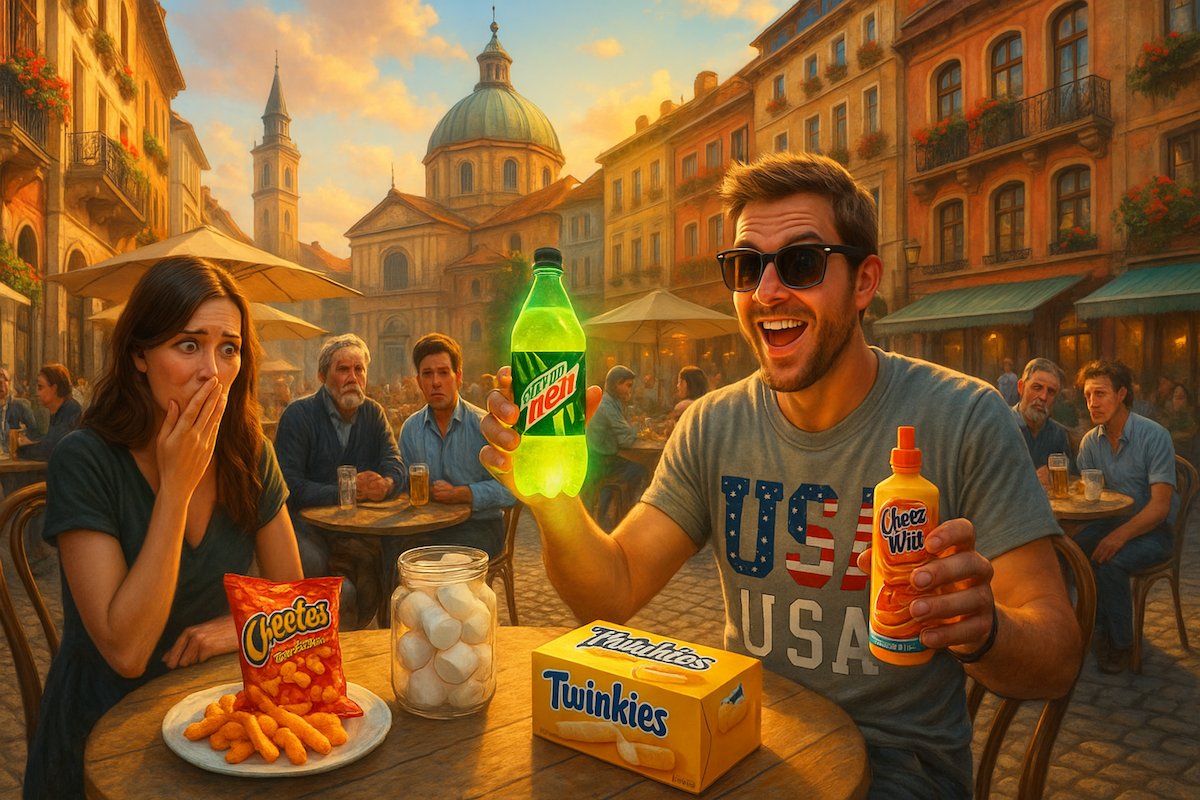Contents
- When Your Favorite Snacks Become a European Horror Story
- 1. “Wait…You ‘Eat’ That?”
- 2. The Great Pop-Tart Mystery
- 3. Spray Cheese: The Ultimate Culinary Crime
- 4. Mountain Dew and the Neon Beverage Apocalypse
- 5. Cheetos: Why Your Fingers Are a Red Flag
- 6. Lucky Charms and the Breakfast Candy Scandal
- 7. Flamin’ Hot Everything: “Do Americans Hate Their Mouths?”
- What This Says About Us… And Why It Stings
- Before You Pack That Snack Abroad…
- So, Are We the Weird Ones?
When Your Favorite Snacks Become a European Horror Story
From glowing snacks and drinks to marshmallows for breakfast… here’s what makes Europeans gag.
When I offered a French friend I’d met along the Camino de Santiago a bag of Flamin’ Hot Cheetos during lunch (tucked safely in my backpack as an “essential”), he didn’t just decline.
He held the bag like it was radioactive.
“Why do Americans eat food that glows?” he asked, genuinely baffled.
At first, I laughed. But then I realized… he wasn’t joking.
What started as a lighthearted snack break and a comical “cultural exchange” along the Camino, quickly turned into a full-on comedy roast of American snack culture.
The Flamin’ Hots were just the opening act.
Soon we were onto neon-colored cereals, squeezable cheese, and microwave pancakes in plastic trays.
As someone who’s spent time living in places like France, Georgia, and Ukraine, I’ve learned the hard way that what we casually call “snack time” in the U.S. often gets classified abroad somewhere between “science experiment” and “chemical warfare.”
You think Americans get roasted for our politics?
Wait until you pull out a Lunchables in a Irish hostel kitchen near the Cliffs of Moher. One fellow traveler from France actually asked if it was a toy.
For years, I thought this kind of food was just a harmless indulgence.
Nostalgic, convenient, a little over-processed, sure, but fine.
That is, until I saw those same foods through European eyes.
Eyes that squint at Pop-Tarts like they’re an industrial accident.
Eyes that demand to know why your milk doesn’t expire until next year.
In this article, I’m pulling back the foil wrapper on 7 everyday American snacks that Europeans find downright outrageous.
And if you’ve ever innocently eaten spray cheese on a cracker, you might want to brace yourself. You may love them.
You may have grown up with them.
But overseas?
These snacks are getting laughed out of the room, and you might never look at your pantry the same way again.
Let’s dig in! But maybe not with your fingers… especially if they’re coated in radioactive orange dust.
Mmmmmm, good!
1. “Wait…You ‘Eat’ That?”
I once cracked open a pack of Reese’s in a shared pilgrim’s hostel kitchen in Spain, thinking I was offering a little piece of Americana.
A guy from Italy paused mid-pasta-stir, looked at the chocolate-peanut butter combo, and asked, “Is that dessert or a protein bar?”
When I said “both,” he backed away slowly like I’d just weaponized dessert.
That was the moment I realized many beloved American snacks aren’t just weird to Europeans, they’re wildly offensive to their palates, logic, and sometimes their moral codes.
Reality: What we see as comfort food, many Europeans see as a culinary red flag… and your favorite snack might be more shocking than you think.
2. The Great Pop-Tart Mystery
During a French friend’s visit to the U.S., I once made the mistake of offering Pop-Tarts as a “quick breakfast” before setting off for the day.
My friend stared at me like I’d called a Snickers bar a salad. “That’s not breakfast. That’s dessert for people in a hurry to die,” he muttered.
He wasn’t wrong. Pop-Tarts contain more sugar than some French pastries, minus the artistry and butter.
It’s a frosted brick of childhood nostalgia… and in Europe, it’s filed under “dessert or dangerous, depending on the flavor.”
Reality: In Europe, pastry is an art.
In America, it’s shelf-stable for two years and doubles as drywall insulation.
3. Spray Cheese: The Ultimate Culinary Crime
Ah yes, fromage en aerosol. I’ll never forget trying to explain Easy Cheese to someone in Lake Lucerne, Switzerland.
“Wait… you press a button and cheese comes out?” she asked. “Like shaving cream?”
Followed by, “And you put that on what, exactly?”
Spray cheese is America’s answer to artisanal food, if the question is, “How can we get dairy into a can and make it last until the next century?”
Reality: Europeans treat cheese like a sacred ritual. We shoot it onto crackers like culinary graffiti.
4. Mountain Dew and the Neon Beverage Apocalypse
In Poland, I grabbed a bottle of Mountain Dew at a gas station. The cashier did a double take, then said in Polish (with genuine concern), “You know that’s not juice, right?”
Yes. Yes, I do.
But I also know it’s one of America’s finest chemical triumphs.
With its electric glow and questionable ingredients, Mountain Dew isn’t a drink, it’s a dare.
To many Europeans, it looks like coolant.
And, in all honesty, it kind of tastes like it too.
Reality: If your drink could double as a glow stick, don’t expect it to be taken seriously outside the U.S.
5. Cheetos: Why Your Fingers Are a Red Flag
During a language exchange in Ukraine, I once brought a snack bag of Cheetos I brought back from the States to share with my fellow language exchange members.
One girl took one look at my fingers, now coated in radioactive orange, and said: “Are you okay? Did you touch something toxic?”
I offered her one. She sniffed it, frowned, and whispered: “Is this real food?”
Reality: In Europe, food isn’t supposed to dye your skin.
In the U.S., we treat snack residue like a badge of honor.
6. Lucky Charms and the Breakfast Candy Scandal
In Spain, I once described Lucky Charms as “a cereal with marshmallows.” I got a polite but horrified stare. “Marshmallows… for breakfast?” one fellow pilgrim said. “In Spain, that would get you a doctor’s referral.”
And he was right. Even the sweet cereals in Europe look like adult food.
Lucky Charms, on the other hand, looks like something you’d feed a unicorn, if that unicorn had a sugar addiction and a death wish.
Reality: European kids eat bread with a little jam. American kids eat rainbow marshmallows and call it fiber.
7. Flamin’ Hot Everything: “Do Americans Hate Their Mouths?”
Over dinner at cookout at a family dacha in Ukraine, I once pulled out a bottle of Sriracha I’d brought back from the U.S…. a small act of culinary self-defense.
My Ukrainian hosts looked on with a mix of confusion and concern as I added a few drops to my plate.
My ex-girlfriend’s father, who once declared ketchup “too spicy,” watched me sweat and sniffle like I was having a medical episode.
In my experience, Ukrainians have an uncanny aversion to anything that even flirts with heat.
I almost pulled out the bag of Flamin’ Hot Doritos I had tucked away, but that felt like a bridge too far.
If I had tried to push my luck, it might’ve been a long walk back to Kyiv.
Meanwhile, back home, we treat spice like a competitive sport.
Reality: If your condiment requires tissues, milk, and makes people question your sanity, it might not travel well.
What This Says About Us… And Why It Stings
So why are these snacks such a cultural punchline abroad? Because in places like France, Spain, and even Ukraine, food is still a daily ritual… something shared, savored, respected.
In America, it’s often engineered for shelf life, sugar spikes, and convenience.
We’re nostalgic for the stuff we grew up with. We crave flavor, fun, and food that fits in a cup holder.
But sometimes, what feels normal at home looks like an edible warning label abroad.
Reality: Cultural blind spots don’t just show up in politics or language, they live in your snack drawer too.
Before You Pack That Snack Abroad…
If you’re headed overseas, maybe don’t bring the Cheese Balls. Or do, but be ready for commentary. Probably a lot of it.
American snacks are bold, colorful, over-the-top… and in Europe, often considered edible comedy.
But hey, some of them taste like childhood. And rebellion.
And, yes, maybe a little radiation.
Which snack do you refuse to give up… even if the rest of the world thinks you’re insane for loving it?
So, Are We the Weird Ones?
The next time you crack open a bag of Cheetos abroad or unwrap a Pop-Tart in a Paris café, take a moment.
Notice the stares. The judgment, and the slow recoil.
Then smile, and maybe offer them a bite.
If they’re brave enough.
Because as I learned writing “8 Shocking American Foods Banned in Europe”, this conversation goes way beyond what’s legal.
It’s about what’s normal, and just how different that can look, depending on where you open your lunchbox.
What’s the one snack you’ll never quit… even if it’s the food equivalent of an international scandal?

David Peluchette is a Premium Ghostwriter/Travel and Tech Enthusiast. When David isn’t writing he enjoys traveling, learning new languages, fitness, hiking and going on long walks (did the 550 mile Camino de Santiago, not once but twice!), cooking, eating, reading and building niche websites with WordPress.

